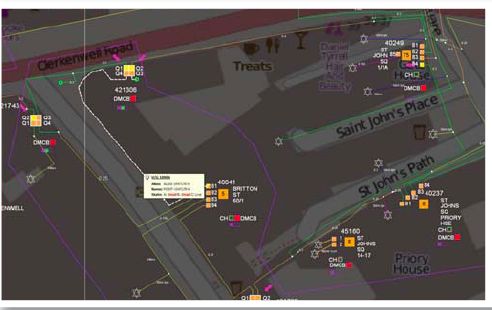Here’s one measure of the value of marrying the smart grid with software: $387 million. U.K. utilities Scottish and Southern Energy and U.K. Power Networks believe they can save that much money in distribution system upgrades over the coming years, if they’re allowed to put a suite of software and sensors from General Electric to broader use in how they plan for, and get paid for, maintaining the grid.
Consider it an important measure of the benefits of investing in distributed intelligence and data analytics for the grid -- even though GE isn’t saying how much it cost to get the systems up and running. Certainly there will be opportunity to discuss the cost-benefit equations of distributed intelligence and data analytics efforts like these at Greentech Media’s Soft Grid 2014 conference this week in Menlo Park, Calif.
GE’s claim is based on its pilot work with SSE’s Thames Valley Vision, as well as with U.K. Power Networks’ Flexible Urban Networks and Smart Urban Low Voltage Network programs. These initiatives have a combined funding of £33 million ($53 million), with more than half provided by the U.K.’s Low Carbon Network Fund (LCNF). That means they’re aimed at integrating as much customer-side energy efficiency and distributed generation as they can, with the end goal of meeting looming carbon reduction mandates.
But the savings GE laid out in a press release last month will come primarily from avoiding the expensive work of tearing up streets to retrofit underground distribution circuits and transformers, or building new power lines just to meet brief periods of peak demand. Instead, GE says it can use data from smart meters, SCADA systems and its Multilin sensors to allow grid operators to use power circuits at closer to their true peak capacity, pinpoint specific “hot spots” that need to be upgraded or addressed through distributed resources -- and avoid wasting money where it’s not needed. According to last month’s press release, the two utilities forecast savings of more than €300 million [$387 million] in avoidable capital expenditures, which is money they can now spend to “maximize their existing infrastructure and improve operational efficiency.”
“There’s a key avoidance here -- avoiding major reinforcement of the network, especially in a city center or downtown, but anywhere you can avoid adding wires,” Dave Daly, director of ADMS for GE's Digital Energy business, said in an interview last week. “You’re using software to release that capacity back to the consumer.”
We’ve been covering the work underway in California and New York to restructure distribution grid operations and planning to take distributed solar PV, plug-in electric vehicles, energy storage, energy-smart homes and buildings and other grid-edge assets into account. In the U.K., distribution network operators like SSE and UKPN are going through a similar process, driven by the country’s decarbonization goals, but also aimed at solving their own problems in managing distributed generation and demand-side resources, Daly said.
LCNF projects around the U.K. range from distributed voltage regulators in Blackburn, Lancashire, to automated demand response in London. GE has worked with demand-side partners like Honeywell on its U.K. projects, and is integrating smart meters, sensors and grid power electronics devices from different vendors to manage the grid itself, Daly noted.
GE’s technology “stack” includes its advanced distribution management system (ADMS), its GIS platform, and its metering head-end Smart Metering Operational Suite (SMOS). The work starts with building a functional low-voltage network model, built on existing GIS, DMS and SCADA data, available smart-meter data, and for the spots that need it, purpose-deployed grid sensors.

Much depends on what data is there to begin with, Daly said. London has a well-monitored SCADA network for its mostly underground distribution grid, while the town of Bracknell in SSE’s Thames Valley Vision project requires more of GE’s Multilin sensors to get the data required.
The U.K.’s approach to smart metering is another wrinkle for GE to work around, he noted. Unlike the U.S., where utilities own and operate their smart meters, the U.K.’s distribution network operators have to share access with retail energy providers and share data with a central government-funded repository and clearinghouse, which has led to uncertainty about who will own the data, as well as how quickly it will be delivered to grid operators.
“We’ve found it’s better to use a mixture,” he said, relying on smart meters where they’re available, and sensors that are “more targeted, from the LV up to the secondary substation. We can be very targeted on network hot spots -- you don’t have to have it across the entire network.”
The term “hot spots” refers to points of network stress, where demand for electricity is exceeding grid capacity, or where intermittent wind and solar power are causing power-flow disruptions. As Daly put it, “The power of an ADMS is to release the contingency” that exists in the network. Every distribution circuit is originally designed with a certain amount of contingency -- a safety margin for operators, which haven't changed much, even as conditions on the grid have progressed.
“You had to do that when you were blind on the network,” he said. “Now you have visibility.” That allows utilities to discover the latent ability to provide more power or grid stability from the data they’re collecting, and to take action to harness it. “The longer they can utilize the current physical limit and still meet increasing demand -- [it may be possible to accrue] in the tens of millions of dollars in savings, just locally,” he said.
Knowing just where the grid is most stressed also allows utilities to focus on those spots, instead of blanketing their entire territory with grid upgrades, he said. GE’s ADMS is able to incorporate rooftop solar and other distributed resources into its models, and the company is partnering with a U.K. university to study and forecast consumer demand for PV, EVs and other grid-edge products and services, in order to feed back this information into the planning process, he said.
“Now that you’ve got the model, you can move more and more applications to active network management,” he added. Utilities still want the confidence of using their own data to make decisions, he noted. But GE is also working with demand-side management, like Honeywell’s OpenADR platform in the Thames Valley project, to reduce load with near-real-time reaction speeds.
The U.K.’s Office of Gas and Electricity Markets has identified about £32 billion in energy network investments needed to reach the country's carbon reduction and renewable energy goals, representing a 75 percent increase in the value of Britain’s existing energy network over the next twenty years. But current utility regulations still favor investments in old-school central generation and one-way power delivery.
The U.K. has embarked on a massive restructuring of its energy regime, known as RIIO (Revenue=Incentives+Innovation+Outputs), to bring performance-based models into play (PDF). These kinds of regulatory changes will be needed to allow investments into integrated software, sensor and grid control solutions, like those GE is delivering in these government-funded projects today, to compete on a level playing field with traditional capital investments.
“It’s an emerging market, as far as utilities building their low-voltage sensor networks out,” he said. “We’d expect other countries to look at the learnings here and apply them to their own grids.”



